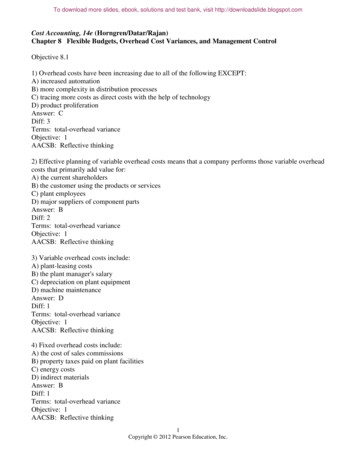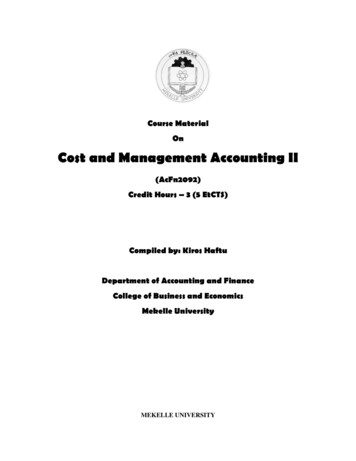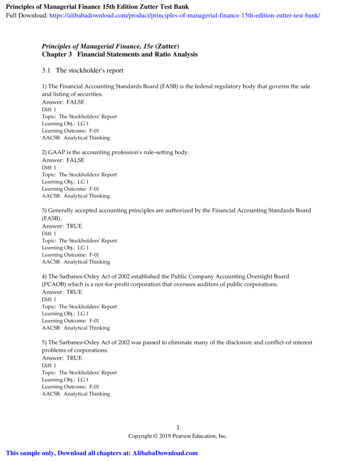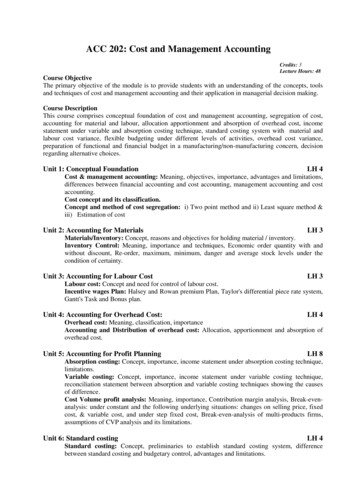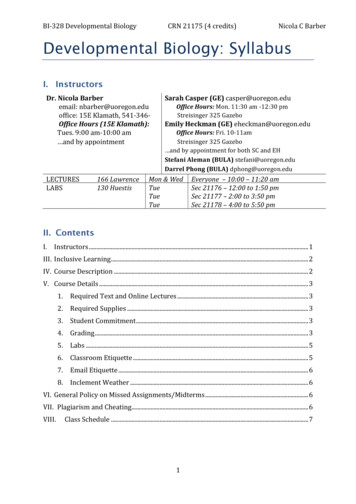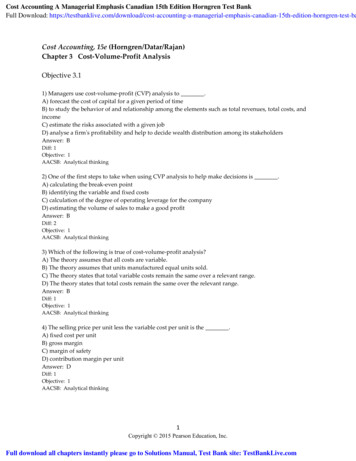
Transcription
Cost Accounting A Managerial Emphasis Canadian 15th Edition Horngren Test BankFull Download: en-test-baCost Accounting, 15e (Horngren/Datar/Rajan)Chapter 3 Cost-Volume-Profit AnalysisObjective 3.11) Managers use cost-volume-profit (CVP) analysis to .A) forecast the cost of capital for a given period of timeB) to study the behavior of and relationship among the elements such as total revenues, total costs, andincomeC) estimate the risks associated with a given jobD) analyse a firm's profitability and help to decide wealth distribution among its stakeholdersAnswer: BDiff: 1Objective: 1AACSB: Analytical thinking2) One of the first steps to take when using CVP analysis to help make decisions is .A) calculating the break-even pointB) identifying the variable and fixed costsC) calculation of the degree of operating leverage for the companyD) estimating the volume of sales to make a good profitAnswer: BDiff: 2Objective: 1AACSB: Analytical thinking3) Which of the following is true of cost-volume-profit analysis?A) The theory assumes that all costs are variable.B) The theory assumes that units manufactured equal units sold.C) The theory states that total variable costs remain the same over a relevant range.D) The theory states that total costs remain the same over the relevant range.Answer: BDiff: 1Objective: 1AACSB: Analytical thinking4) The selling price per unit less the variable cost per unit is the .A) fixed cost per unitB) gross marginC) margin of safetyD) contribution margin per unitAnswer: DDiff: 1Objective: 1AACSB: Analytical thinking1Copyright 2015 Pearson Education, Inc.Full download all chapters instantly please go to Solutions Manual, Test Bank site: TestBankLive.com
5) In the graph method of CVP analysis, the total revenues line always begins from the x-axis and thetotal costs line begins from the fixed cost line.Answer: TRUEDiff: 2Objective: 1AACSB: Analytical thinking6) Which of the following is an assumption of CVP analysis?A) Total costs can be divided into a fixed component and a component that is variable with respect to thelevel of output.B) When graphed, total costs curve upward.C) The unit-selling price is variable as it is subject to demand and supply.D) Total costs can be divided into inventoriable and period costs with respect to the level of output.Answer: ADiff: 2Objective: 1AACSB: Analytical thinking7) Which of the following is true of CVP analysis?A) Costs may be separated into separate inventoriable and period components with respect to the level ofoutput.B) Total revenues and total costs are linear in relation to output units.C) Unit selling price, unit variable costs, and unit fixed costs are known and remain constant.D) Proportion of different products will vary according to demand and supply when multiple productsare sold.Answer: BDiff: 2Objective: 1AACSB: Analytical thinking8) A revenue driver is defined as .A) any factor that affects costs and revenuesB) any factor that affects revenuesC) the only factor that can influence a change in selling priceD) the only factor that can influence a change in demandAnswer: BDiff: 1Objective: 1AACSB: Analytical thinking9) As per CVP, operating income calculations use .A) net income and dividendsB) income tax expense and net incomeC) contribution margins and fixed costsD) nonoperating revenues and nonoperating expensesAnswer: CDiff: 1Objective: 1AACSB: Analytical thinking2Copyright 2015 Pearson Education, Inc.
10) Which of the following is true about the assumptions underlying basic CVP analysis?A) Selling price varies with demand and supply of the product.B) Only selling price and variable cost per unit are known and constant.C) Only selling price, variable cost per unit, and total fixed costs are known and constant.D) Selling price, variable cost per unit, fixed cost per unit, and total fixed costs are known and constant.Answer: CDiff: 1Objective: 1AACSB: Analytical thinking11) The contribution margin income statement .A) reports gross marginB) is allowed for external reporting to shareholdersC) categorizes costs as either direct or indirectD) can be used to predict future profits at different levels of activityAnswer: DDiff: 1Objective: 1AACSB: Analytical thinking12) Contribution margin equals .A) revenues minus period costsB) revenues minus product costsC) revenues minus variable costsD) revenues minus fixed costsAnswer: CDiff: 1Objective: 1AACSB: Analytical thinkingAnswer the following questions using the information below:Shine Jewelry sells 400 units resulting in 7,000 of sales revenue, 3,000 of variable costs, and 1,500 offixed costs.13) Contribution margin per unit is .A) 4.00B) 11.00C) 10.00D) 8.00Answer: CExplanation: C) ( 7,000 3,000) / 400 units 10 per unitDiff: 2Objective: 1AACSB: Application of knowledge3Copyright 2015 Pearson Education, Inc.
14) Calculate the variable cost per unit.A) 11.00B) 7.00C) 8.00D) 7.50Answer: DExplanation: D) 3,000 / 400 7.50Diff: 2Objective: 1AACSB: Application of knowledgeAnswer the following questions using the information below:Tally Corp. sells softwares during the recruiting seasons. During the current year, 11,000 softwares weresold resulting in 440,000 of sales revenue, 110,000 of variable costs, and 48,000 of fixed costs.15) Contribution margin per software is .A) 10.00B) 30.00C) 40.00D) 36.00Answer: BExplanation: B) ( 440,000 110,000) / 11,000 30 per softwareDiff: 2Objective: 1AACSB: Application of knowledge16) If sales increase by 60,000, operating income will increase by .A) 10,000B) 40,000C) 45,000D) 60,000Answer: DExplanation: D) Price 440,000 / 11,000 40.00Sales in softwares 60,000 / 30.00 2,000 softwaresOperating income increase 2,000 softwares 30.00 per 60,000Diff: 2Objective: 1AACSB: Application of knowledge4Copyright 2015 Pearson Education, Inc.
17) Pacific Company sells only one product for 11 per unit, variable production costs are 3 per unit, andselling and administrative costs are 1.50 per unit. Fixed costs for 10,000 units are 5,000. The operatingincome is .A) 6.50 per unitB) 6.00 per unitC) 5.50 per unitD) 5.00 per unitAnswer: BExplanation: B) Operating income 11 3 1.50 - ( 5,000 / 10,000) 6.00Diff: 2Objective: 1AACSB: Application of knowledge18) The contribution income statement highlights .A) gross marginB) the segregation of costs into period costs and inventoriable costsC) different product linesD) variable and fixed costsAnswer: DDiff: 1Objective: 1AACSB: Analytical thinking19) Fixed costs equal 15,000, unit contribution margin equals 25, and the number of units sold equal1,150. Operating income is .A) 28,750B) 13,750C) 15,000D) 14,750Answer: BExplanation: B) (1,150 25) 15,000 13,750Diff: 2Objective: 1AACSB: Application of knowledge5Copyright 2015 Pearson Education, Inc.
Answer the following questions using the information below:Northern Star sells several products. Information of average revenue and costs is as follows:Selling price per unit 20.00Variable costs per unit:Direct material 4.00Direct manufacturing labor 1.60Manufacturing overhead 0.40Selling costs 2.00Annual fixed costs 96,000The company sells 12,000 units at the end of the year.20) The contribution margin per unit is .A) 11.00B) 12.00C) 4.00D) 14.00Answer: BExplanation: B) Contribution margin per unit ( 20 4 1.60 0.40 2) 12Diff: 2Objective: 1AACSB: Application of knowledge21) If direct labor and direct material costs increase by 1 each, contribution margin .A) increases by 20,000B) increases by 14,000C) decreases by 24,000D) decreases by 14,000Answer: CExplanation: C) Contribution margin ( 20 5 2.60 0.40 2) 12,000 120,000.Diff: 3Objective: 1AACSB: Application of knowledge6Copyright 2015 Pearson Education, Inc.
Answer the following questions using the information below:Bell Company sells several products. Information of average revenue and costs is as follows:Selling price per unitVariable costs per unit:Direct materialDirect manufacturing laborManufacturing overheadSelling costsAnnual fixed costsThe company sells 10,000 units. 28.50 5.25 1.15 0.25 1.85 110,00022) The contribution margin per unit is .A) 15B) 20C) 22D) 125Answer: BExplanation: B) Contribution margin per unit 28.50 5.25 1.15 0.25 1.85 20.00Diff: 2Objective: 1AACSB: Application of knowledge23) What is the proportion of variable costs to total costs?A) 45.00%B) 48.56%C) 53.56%D) 43.56%Answer: DExplanation: D) Total variable costs 5.25 1.15 0.25 1.85 8.50 10,000 85,000Total costs 85,000 110,000 195,000.Variable cost proportion 85,000 / 195,000 43.56%Diff: 2Objective: 1AACSB: Application of knowledge7Copyright 2015 Pearson Education, Inc.
Answer the following questions using the information below:Alex Furniture sells a table for 850. His fixed costs are 25,000, while his variable costs are 500 per table.He currently plans to sell 175 tables this month.24) What is the budgeted revenue for the month assuming that Alex sells 175 tables?A) 145,750B) 148,750C) 150,000D) 142,250Answer: BExplanation: B) Budgeted revenue 175 850 148,750Diff: 2Objective: 1AACSB: Application of knowledge25) What is the budgeted operating income for the month assuming that Alex sells 175 tables?A) 45,250B) 37,000C) 36,250D) 36,750Answer: CExplanation: C) Budgeted operating income 148,750 [(175 500) 25,000] 148,750 112,500 36,250Diff: 2Objective: 1AACSB: Application of knowledge26) Winnz sells 8,000 units resulting in 100,000 of sales revenue, 35,000 of variable costs, and 45,000 offixed costs. The contribution margin percentage is .A) 66.67%B) 65.0%C) 37.5%D) 75.0%Answer: BExplanation: B)( 100,000 35,000) / 100,000 65%Diff: 2Objective: 1AACSB: Application of knowledge27) Which of the following is the mathematical expression of contribution margin ratio?A) Contribution margin ratio Contribution margin percentage Revenues (in dollars)B) Contribution margin ratio Contribution margin percentage Fixed costs (in dollars)C) Contribution margin ratio Contribution margin percentage Variable costs (in dollars)D) Contribution margin ratio Contribution margin percentage Operating leverageAnswer: ADiff: 1Objective: 1AACSB: Analytical thinking8Copyright 2015 Pearson Education, Inc.
28) While doing cost-volume-profit analysis, a company should separate costs into fixed and variablecomponents.Answer: TRUEDiff: 1Objective: 1AACSB: Analytical thinking29) Sales margin Contribution margin percentage Revenues (in dollars).Answer: FALSEDiff: 1Objective: 1AACSB: Analytical thinking30) It is assumed in CVP analysis that the unit selling price, unit variable costs, and unit fixed costs areknown and constant.Answer: FALSEExplanation: It is assumed in CVP analysis that the unit selling price, unit variable costs, and total fixedcosts are known and constant.Diff: 1Objective: 1AACSB: Analytical thinking31) In CVP analysis, the number of output units is the only revenue driver.Answer: TRUEDiff: 1Objective: 1AACSB: Analytical thinking32) In CVP analysis, the graph of total revenues versus total costs is linear in nature relation to units soldwithin a relevant range and time period.Answer: TRUEDiff: 1Objective: 1AACSB: Analytical thinking33) The difference between total revenues and total variable costs is called profit margin.Answer: FALSEExplanation: The difference between total revenues and total variable costs is called contribution margin.Diff: 2Objective: 1AACSB: Analytical thinking34) The shorter the time horizon, the lower the percentage of total costs considered fixed.Answer: FALSEExplanation: The shorter the time horizon, the higher the percentage of total costs considered fixed.Diff: 2Objective: 1AACSB: Analytical thinking9Copyright 2015 Pearson Education, Inc.
35) The three methods used to study CVP analysis are graphical method, contribution method, andequation method.Answer: TRUEDiff: 1Objective: 1AACSB: Analytical thinking36) Contribution margin Contribution margin percentage Revenues (in dollars).Answer: TRUEDiff: 1Objective: 1AACSB: Analytical thinking37) A revenue driver is a variable, such as volume, that causally affects revenues.Answer: TRUEDiff: 1Objective: 1AACSB: Analytical thinking38) Operating income plus total fixed costs equals the contribution margin.Answer: TRUEExplanation: Total revenues less total variable costs equal the contribution margin.Diff: 2Objective: 1AACSB: Analytical thinking39) A revenue driver is a variable, such as volume, that causally affects revenues.Answer: TRUEExplanation: Gross margin is reported on the absorption costing income statement.Diff: 1Objective: 1AACSB: Analytical thinking40) The classification of costs as variable and fixed depends on the relevant range, the length of the timehorizon, and the specific decision situation.Answer: TRUEDiff: 2Objective: 1AACSB: Application of knowledge41) The difference between total revenues and total variable costs is called contribution margin.Answer: TRUEDiff: 1Objective: 1AACSB: Analytical thinking10Copyright 2015 Pearson Education, Inc.
42) Contribution margin per unit is a useful tool for calculating contribution margin and operatingincome.Answer: TRUEExplanation: True, because all variable costs are subtracted to compute contribution margin, but onlyCOGS is subtracted to compute gross margin.Diff: 2Objective: 1AACSB: Analytical thinking43) Arthur's Plumbing reported the following:RevenuesVariable manufacturing costsVariable nonmanufacturing costsFixed manufacturing costsFixed nonmanufacturing costs 4,500 900 810 630 545Required:a. Compute contribution margin.b. Compute contribution margin percentage.c. Compute gross margin.d. Compute gross margin percentage.e. Compute operating income.Answer:a. Contribution margin 4,500 - 900 - 810 2,790b. Contribution margin percentage ( 2,790/ 4,500) 100 62%c. Gross margin 4,500 - 900 - 630 2,970d. Gross margin percentage ( 2,970/ 4,500) 100 66%e. Operating income 4,500 - 900 - 810 - 630 - 545 1,615Diff: 3Objective: 1AACSB: Application of knowledge11Copyright 2015 Pearson Education, Inc.
Objective 3.21) Winnz sells 8,000 units resulting in 100,000 of sales revenue, 35,000 of variable costs, and 45,000 offixed costs. To achieve 150,000 in operating income, sales must total .A) 440,000B) 160,000C) 130,000D) 300,000Answer: DExplanation: D) ( 150,000 45,000) / 65% 300,000 in salesDiff: 2Objective: 2AACSB: Application of knowledgeAnswer the following questions using the information below:Star Jewelry sells 500 units resulting in 75,000 of sales revenue, 28,000 of variable costs, and 18,000 offixed costs.2) Breakeven point in units is .A) 196 unitsB) 203 unitsC) 185 unitsD) 192 unitsAnswer: DExplanation: D) Contribution margin per unit ( 75,000 28,000) / 500 94Breakeven point 18,000 / 94 191.49 units. Hence breakeven is approximately 192 units.Diff: 2Objective: 2AACSB: Application of knowledge3) The number of units that must be sold to achieve 40,000 of operating income is .A) 677 unitsB) 717 unitsC) 617 unitsD) 650 unitsAnswer: CExplanation: C) ( 75,000 28,000) / 500 94The number of units that must be sold to achieve 40,000 of operating income ( 18,000 40,000) / 94 617 unitsDiff: 2Objective: 2AACSB: Application of knowledge12Copyright 2015 Pearson Education, Inc.
4) Sky High sells helicopters. During the current year, 100 helicopters were sold resulting in 820,000 ofsales revenue, 250,000 of variable costs, and 342,000 of fixed costs. Breakeven point in units is .A) 80 unitsB) 64 unitsC) 60 unitsD) 78 unitsAnswer: CExplanation: C) Explanation: Contribution margin per unit ( 820,000 - 250,000) / 100 570,000 / 100 5,700 per unit.Breakeven point 342,000 / 5,700 60 unitsDiff: 2Objective: 2AACSB: Application of knowledge5) Sky High sells helicopters. During the current year, 100 helicopters were sold resulting in 820,000 ofsales revenue, 250,000 of variable costs, and 342,000 of fixed costs. The number of helicopters that mustbe sold to achieve 300,000 of operating income is .A) 113 unitsB) 102 unitsC) 96 unitsD) 100 unitsAnswer: AExplanation: A) Number of helicopters to be sold to achieve an operating income of 300,000 ( 342,000 300,000) / 5,700 112.6 units 113 unitsDiff: 2Objective: 2AACSB: Application of knowledge6) At the breakeven point of 2,000 units, variable costs total 4,000 and fixed costs total 6,000. The 2,001stunit sold will contribute to profits.A) 1B) 2C) 3D) 5Answer: CExplanation: C) Fixed costs of 6,000/2,000 units Contribution Margin of 3 per unit.Diff: 2Objective: 2AACSB: Application of knowledge7) The breakeven point is the activity level where .A) revenues equal fixed costsB) revenues equal variable costsC) contribution margin equals total costsD) revenues equal the sum of variable and fixed costsAnswer: DDiff: 1Objective: 2AACSB: Analytical thinking13Copyright 2015 Pearson Education, Inc.
8) Breakeven point in units is .A) total costs divided by profit margin per unitB) contribution margin per unit divided by total cost per unitC) fixed costs divided by contribution margin per unitD) the sum of fixed and variable costs divided by contribution margin per unitAnswer: CDiff: 1Objective: 2AACSB: Analytical thinking9) Sales total 400,000 when variable costs total 300,000 and fixed costs total 50,000. The breakevenpoint in sales dollars is .A) 200,000B) 120,000C) 170,000D) 210,000Answer: AExplanation: A) Contribution margin percentage ( 400,000 300,000) / 400,000 25%;BE sales 50,000 / 0.25 200,000Diff: 3Objective: 2AACSB: Application of knowledge10) The breakeven point revenues is calculated by dividing .A) fixed costs by total revenuesB) fixed costs by contribution margin percentageC) total revenues by fixed costsD) contribution margin percentage by fixed costsAnswer: BDiff: 2Objective: 2AACSB: Analytical thinking11) At breakeven point, .A) operating income is equal to zeroB) contribution margin minus fixed costs is equal to profits earnedC) revenues equal fixed costs minus variable costsD) breakeven revenues equal fixed costs divided by the variable cost per unitAnswer: ADiff: 2Objective: 2AACSB: Analytical thinking14Copyright 2015 Pearson Education, Inc.
12) The breakeven point decreases if .A) the variable cost per unit increasesB) the total fixed costs decreaseC) the contribution margin per unit decreasesD) the selling price per unit decreasesAnswer: BDiff: 2Objective: 2AACSB: Application of knowledge13) Assume only the specified parameters change in a CVP analysis. The contribution margin percentageincreases when .A) total fixed costs increaseB) total fixed costs decreaseC) variable costs per unit increaseD) variable costs per unit decreaseAnswer: DDiff: 1Objective: 2AACSB: Analytical thinking14) What is the breakeven point in units, assuming a product's selling price is 100, fixed costs are 16,000, unit variable costs are 20, and operating income is 5,200?A) 100 unitsB) 300 unitsC) 400 unitsD) 200 unitsAnswer: DExplanation: D) Unit contribution margin 100 20 80.Breakeven point in units 16,000 / 80 200 unitsDiff: 2Objective: 2AACSB: Application of knowledge15) If unit outputs exceed the breakeven point .A) there will be an increase in fixed costsB) total sales revenue will exceed fixed costsC) total sales revenue will exceed variable costsD) there will be a profitAnswer: DDiff: 2Objective: 2AACSB: Application of knowledge15Copyright 2015 Pearson Education, Inc.
16) How many units would have to be sold to yield a target operating income of 23,000, assumingvariable costs are 25 per unit, total fixed costs are 2,000, and the unit selling price is 30?A) 4,800 unitsB) 4,400 unitsC) 5,000 unitsD) 5,200 unitsAnswer: CExplanation: C) Desired sales ( 2,000 23,000) / ( 30 25) 5,000 unitsDiff: 3Objective: 2AACSB: Application of knowledge17) If the breakeven point is 1,000 units and each unit sells for 50, then .A) selling 1,040 units will result in a lossB) selling 60,000 will result in a lossC) selling 50,000 will result in zero profitD) selling 45,000 will result in profitAnswer: CExplanation: C) 1,000 50 50,000 of BE salesDiff: 2Objective: 2AACSB: Application of knowledge18) If breakeven point is 1,000 units, each unit sells for 30, and fixed costs are 10,000, then on a graphthe .A) total revenue line and the total cost line will intersect at 30,000 of revenueB) total cost line will be zero at zero units soldC) revenue line will start at 10,000D) total revenue line and the total cost line will intersect at 40,000 of revenueAnswer: ADiff: 3Objective: 2AACSB: Application of knowledge19) When fixed costs are 50,000 and variable costs are 60% of the selling price, then breakeven sales are.A) 115,000B) 125,000C) 175,000D) 275,000Answer: BExplanation: B) 50,000 / (1 0.60) 125,000 in BE salesDiff: 2Objective: 2AACSB: Application of knowledge16Copyright 2015 Pearson Education, Inc.
Answer the following questions using the information below:Ruben intends to sell his customers a special round-trip airline ticket package. He is able to purchase thepackage from the airline carrier for 150 each. The round-trip tickets will be sold for 200 each and theairline intends to reimburse Ruben for any unsold ticket packages. Fixed costs include 5,000 inadvertising costs.20) What is the contribution margin per ticket package?A) 50B) 100C) 150D) 200Answer: AExplanation: A) 200 - 150 50Diff: 2Objective: 2AACSB: Application of knowledge21) How many ticket packages will Ruben need to sell to break even?A) 34 packagesB) 50 packagesC) 100 packagesD) 150 packagesAnswer: CExplanation: C) 200X - 150X - 5,000 0; X 100Diff: 2Objective: 2AACSB: Application of knowledge22) How many ticket packages will Ruben need to sell in order to achieve 60,000 of operating income?A) 367 packagesB) 434 packagesC) 1,100 packagesD) 1,300 packagesAnswer: DExplanation: D) 200X - 150X - 5,000 60,000; X 1,300Diff: 2Objective: 2AACSB: Application of knowledge23) For every 25,000 of ticket packages sold, operating income will increase by .A) 6,250B) 12,500C) 18,750D) 15,000Answer: AExplanation: A) 25,000 [( 200 - 150 / 200)] 6,250Diff: 3Objective: 2AACSB: Application of knowledge17Copyright 2015 Pearson Education, Inc.
24) Bovous Stores, Inc., sells several products. Information of average revenue and costs is as follows:Selling price per unitVariable costs per unit:Direct materialDirect manufacturing laborManufacturing overheadSelling costsAnnual fixed costs 20.00 4.00 1.60 0.40 2.00 96,000What is the contribution margin percentage?A) 60%B) 66%C) 33%D) 55%Answer: AExplanation: A) Contribution margin percentage ( 20 4.00 1.60 0.40 2.00) / 20 60%Diff: 2Objective: 2AACSB: Application of knowledge25) Bovous Stores, Inc., sells several products. Information of average revenue and costs is as follows:Selling price per unitVariable costs per unit:Direct materialDirect manufacturing laborManufacturing overheadSelling costsAnnual fixed costs 20.00 4.00 1.60 0.40 2.00 96,000The revenues that the company must earn annually to make a profit of 144,000 are .A) 378,000B) 425,000C) 400,000D) 450,000Answer: CExplanation: C) Desired sales ( 96,000 144,000) / 0.60 400,000Diff: 2Objective: 2AACSB: Application of knowledge18Copyright 2015 Pearson Education, Inc.
26) Frazer Corp sells several products. Information of average revenue and costs is as follows:Selling price per unit 28.50Variable costs per unit:Direct material 5.50Direct manufacturing labor 1.15Manufacturing overhead 0.85Selling costs 2.50Annual fixed costs 125,000What is the operating income earned if the company sells 15,000 units?A) 162,750B) 150,000C) 148,500D) 152,500Answer: DExplanation: D) Contribution 28.5 - 5.50 1.15 0.85 - 2.50 18.50 15,000 277,500Operating income 277,500 - 125,000 152,500Diff: 2Objective: 2AACSB: Application of knowledge27) Frazer Corp sells several products. Information of average revenue and costs is as follows:Selling price per unit 28.50Variable costs per unit:Direct material 5.50Direct manufacturing labor 1.15Manufacturing overhead 0.85Selling costs 2.50Annual fixed costs 125,000If the company decides to lower its selling price by 12.25%, the operating income is reduced by .A) 52,500B) 50,500C) 55,500D) 29,500Answer: AExplanation: A) 28.50 12.25% 3.50. Therefore the new selling price is 25.00 ( 28.50 - 3.50).Contribution ( 25.00 - 5.50 1.15 0.85 - 2.50) 15,000 225,000Operating income 225,000 - 125,000 100,000.Diff: 3Objective: 2AACSB: Application of knowledge19Copyright 2015 Pearson Education, Inc.
Answer the following questions using the information below:The following information is for High Corp:Selling priceVariable costsTotal fixed costs 60 per unit 40 per unit 125,00028) The number of units that High Corp must sell to reach targeted operating income of 25,000 is.A) 6,000 unitsB) 7,500 unitsC) 3,334 unitsD) 4,334 unitsAnswer: BExplanation: B) ( 125,000 25,000)/( 60 40) 7,500 unitsDiff: 2Objective: 2AACSB: Application of knowledge29) If targeted operating income is 50,000, then targeted sales revenue is .A) 525,052B) 533,333C) 498,133D) 517,072Answer: AExplanation: A) ( 125,000 50,000) / [( 60 40) / 60] 525,052Diff: 2Objective: 2AACSB: Application of knowledgeAnswer the following questions using the information below:Stephanie's Bridal Shoppe sells wedding dresses. The average selling price of each dress is 1,000,variable costs are 400, and fixed costs are 90,000.30) What is the Bridal Shoppe's operating income when 200 dresses are sold?A) 30,000B) 80,000C) 200,000D) 100,000Answer: AExplanation: A) 200( 1,000) - 200( 400) - 90,000 30,000Diff: 2Objective: 2AACSB: Application of knowledge20Copyright 2015 Pearson Education, Inc.
31) How many dresses are sold when operating income is zero?A) 225 dressesB) 150 dressesC) 100 dressesD) 90 dressesAnswer: BExplanation: B) 1,000N - 400N - 90,000 0; 600N 90,000; N 150 dressesDiff: 3Objective: 2AACSB: Application of knowledge32) Dr. Charles Hunter, MD, performs a certain outpatient procedure for 1,000. His fixed costs are 20,000, while his variable costs are 500 per procedure. Dr. Hunter currently plans to perform 200procedures this month.What is the breakeven point for the month assuming that Dr. Hunter plans toperform the procedure 200 times?A) 40 timesB) 30 timesC) 20 timesD) 10 timesAnswer: AExplanation: A) 1,000N - 500N - 20,000 0; 500N 20,000; N 40 timesDiff: 3Objective: 2AACSB: Application of knowledge33) Pearl Lights sells only pearl necklaces. 8,000 units were sold resulting in 240,000 of sales revenue, 60,000 of variable costs, and 40,000 of fixed costs. The breakeven point in total sales dollars is .A) 40,000B) 53,334C) 100,000D) 58,334Answer: BExplanation: B) 40,000 / ( 240,000 - 60,000) / 240,000 53,334 (rounded up)Diff: 2Objective: 2AACSB: Application of knowledge21Copyright 2015 Pearson Education, Inc.
34) Zealz Manufacturing produces a single product that sells for 80. Variable costs per unit equal 30.The company expects total fixed costs to be 70,000 for the next month at the projected sales level of 2,000units. In an attempt to improve performance, management is considering a number of alternative actions.Each situation is to be evaluated separately. What is the current breakeven point in terms of number ofunits?A) 1,400 unitsB) 2,250 unitsC) 3,333 unitsD) 1725 unitsAnswer: AExplanation: A) 80X 30X 70,000 0; X 1,400 unitsDiff: 2Objective: 2AACSB: Application of knowledge35) Lights Manufacturing produces a single product that sells for 125. Variable costs per unit equal 50.The company expects total fixed costs to be 75,000 for the next month at the projected sales level of 1,000units. What is the current breakeven point in terms of number of units?A) 800 unitsB) 1033 unitsC) 667 unitsD) 1,000 unitsAnswer: DExplanation: D) 75,000/( 125 50) 1,000 unitsDiff: 2Objective: 2AACSB: Application of knowledge36) Which of the following will increase a company's breakeven point?A) increasing variable cost per unitB) increasing contribution margin per unitC) reducing its total fixed costsD) increasing the selling price per unitAnswer: ADiff: 1Objective: 2AACSB: Analytical thinking37) The breakeven point is the quantity of output at which total revenues equal fixed costs.Answer: FALSEExplanation: The breakeven point is the quantity of output at which total revenues equal fixed costs.Diff: 1Objective: 2AACSB: Analytical thinking38) Breakeven point is the point at which operating income is zero.Answer: TRUEDiff: 1Objective: 2AACSB: Analytical thinking22Copyright 2015 Pearson Education, Inc.
39) In the graph method of CVP analysis, the horizontal line above the x-axis represents the total cost line.Answer: FALSEExplanation: In the graph method of CVP analysis, the horizontal line above the x-axis represents thefixed cost line.Diff: 2Objective: 2AACSB: Analytical thinking40) A profit-volume graph shows the impact on operating income from changes in the output level.Answer: TRUEDiff: 1Objective: 2AACSB: Analytical thinking41) In the profit-volume graph the point at which the profit-volume li
Cost Accounting, 15e (Horngren/Datar/Rajan) Chapter 3 Cost-Volume-Profit Analysis Objective 3.1 1) Managers use cost-volume-profit (CVP) analysis to _. A) forecast the cost of capital for a given period of time B) to study the behavior of and relationship among the elements such as total revenues, total costs, and income
